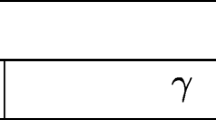Abstract
Consider equipping an alphabet \(\mathcal {A}\) with a group action which partitions the set of words into equivalence classes which we call patterns. We answer standard questions for Penney’s game on patterns and show non-transitivity for the game on patterns as the length of the pattern tends to infinity. We also analyze bounds on the pattern-based Conway leading number and expected wait time, and further explore the game under the cyclic and symmetric group actions.

Similar content being viewed by others
References
Isha Agarwal, Matvey Borodin, Aidan Duncan, Kaylee Ji, Tanya Khovanova, Shane Lee, Boyan Litchev, Anshul Rastogi, Garima Rastogi, and Andrew Zhao. From Unequal Chance to a Coin Game Dance: Variants of Penney’s Game, preprint, arXiv:2006.13002.
Elwyn R. Berlekamp, John H. Conway and Richard K. Guy, Winning Ways for your Mathematical Plays, 2nd Edition, Volume 4, AK Peters, 2004, 885.
Stanley Collings. Coin Sequence Probabilities and Paradoxes, Inst. Math A, 18 (1982), 227–232.
Daniel Felix, Optimal Penney Ante Strategy via Correlation Polynomial Identities, Electr. J. Comb., 13 (2006).
Martin Gardner, Mathematical Games, Sci. Am., 231 (1974), no. 4, 120–125.
Martin Gardner, Time Travel and Other Mathematical Bewilderments, W. H. Freeman, 1988.
L.J. Guibas and A.M. Odlyzko. String Overlaps, Pattern Matching, and Nontransitive Games, J. Comb. Theory A, 30 (1981), no. 2, 183–208.
Steve Humble and Yutaka Nishiyama. Humble-Nishiyama Randomness Game — A New Variation on Penney’s Coin Game, IMA Mathematics Today. 46 (2010), no. 4, 194–195.
Walter Penney, Problem 95. Penney-Ante, J. Recreat. Math., 2 (1969), 241.
Robert W. Vallin. Sequence game on a roulette wheel, published in The Mathematics of Very Entertaining Subjects: Research in Recreational Math, Volume 2, University Press, Princeton, (2017), 286–298.
Acknowledgements
We are grateful to the MIT PRIMES-USA program for giving us the opportunity to conduct this research. On behalf of all authors, the corresponding author states that there is no conflict of interest.
Author information
Authors and Affiliations
Corresponding author
Additional information
Communicated by Ilse Fischer.
Publisher's Note
Springer Nature remains neutral with regard to jurisdictional claims in published maps and institutional affiliations.
Rights and permissions
About this article
Cite this article
Li, S., Khovanova, T. The Penney’s Game with Group Action. Ann. Comb. 26, 145–170 (2022). https://doi.org/10.1007/s00026-021-00564-1
Received:
Accepted:
Published:
Issue Date:
DOI: https://doi.org/10.1007/s00026-021-00564-1




